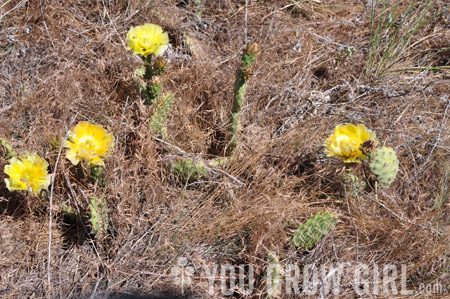
Throughout my gardening life there have been many plants that I tried to grow with middling success, until I observed them growing in the wild. Sarracenia (pitcher plants), venus fly trap (Dioneae muscipula), episcia, and ginger are just a few that come to mind. Seeing them in their natural habitat helped me understand something about the soil, light, moisture, or the communities they grow in that allowed me to better approximate their needs at home in my own garden and pots.
In June 2011 I travelled to Denver, Colorado to speak at the Denver Botanic Gardens. One of many things I was excited to see in the area were cold hardy cactus growing in the wild. I’ve been growing Opuntia humifusa and other hardy cacti in pots for years and had only recently began to have success with them in the ground. But I still felt that there was something that I was missing.
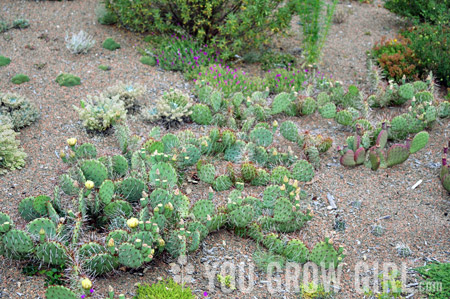
A pretty typical cactus garden with lots of space between plants. Note that I took this photo on the roof of one of the buildings at Denver Botanic Gardens.
Until that time I had only seen hardy cacti growing in gardens. Gardens are environments planted, maintained, and controlled by humans. To varying degrees, we gardeners are selective about what we plant, how we plant them, and how we allow them to grow (or not grow). This is cultivation. Even those of us that espouse a “wilder” temperament and style tend to do at least a little pruning and weeding. As a result, the communities that are formed in a garden are often very different than the ones that are formed when plants are left alone.
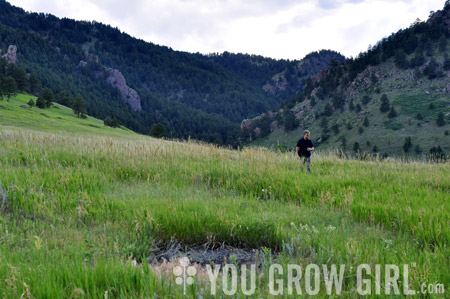
Boulder, Colorado
I spotted the first hardy opuntia off of a hiking trail on a hill in Boulder, Colorado. [Thanks to Shayna for taking us on a field trip there!] I knew I would find them there and I knew they would be small so I started looking down low the second my feet hit the trail. What I did not expect was the field of thick grass, nor did I expect to find the opuntia blanketed and completely shaded out within it!
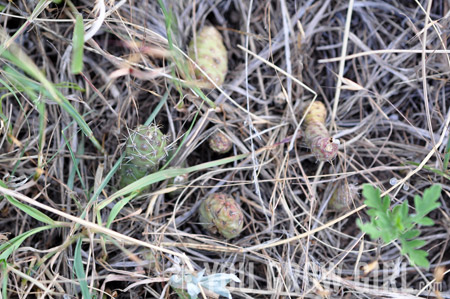
This confusing predicament followed me throughout the trip. Wherever I saw hardy opuntia, whether it was on that hill in Boulder, or later, on the sides of dusty dirt roads or the edges of farmland in Nebraska and the rolling hills outside of Denver — they were always almost entirely covered by grass!!
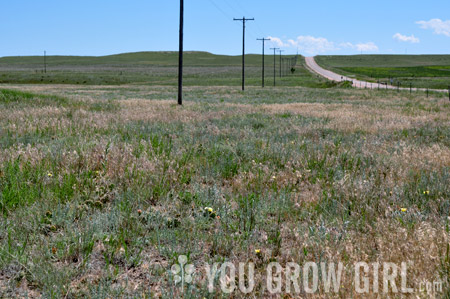
Opuntia growing on the edge of a farm field in Nebraska
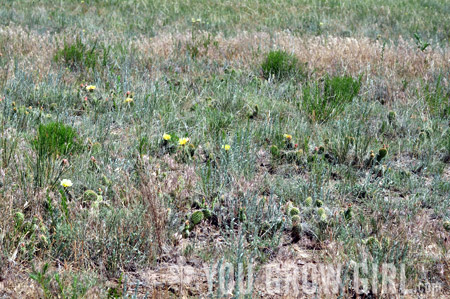
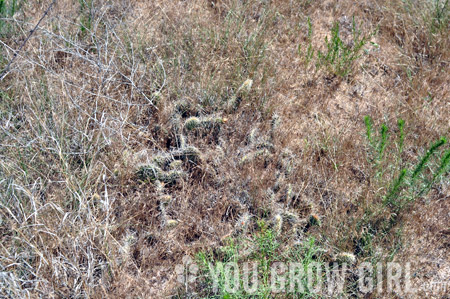
I’ve thought a lot about this since the trip. I’ve searched for an explanation in books. I’ve asked other hardy cactus gardeners. I keep coming up short. Clearly the opuntia do not mind being shaded out by the grasses. They were robust plants. The competition for other resources (like water) didn’t seem to hurt their numbers. The only explanation I can muster is that as the opuntia do their thing and spread through the grassland, the grass provides coverage from extreme wind and sun. The elevation is much higher there than it is here in Toronto. The sunlight is more intense and they receive more days of it. My guess is that the web-like roots of the grasses also helps to keep the cacti in place, especially when it is windy. They also help prevent erosion, so while there may be competition for resources, the grasses also help to prevent those resources from escaping faster.

My dry bed garden, August 2012. (Sorry about the low-quality cellphone pic. I couldn’t find a similar one in my photo archive that shows the overgrowth.)
This summer I did a little test in my dry bed garden. The ‘Buttercream’ California poppies that I planted came up fast and furiously and many grew over the opuntia. And I let them do it. I cut them back here and there to let light in. After-all, we are not as high elevation here and I know that the sun is important in helping them survive the winter. However, I allowed them to grow more freely than I would have had I not visited Colorado and Nebraska and saw the opuntia growing like this. It wasn’t just the conditions itself that I was interested in mimicking. I loved the softer, wilder touch the co-mingling of spiny and tangly plants offered as opposed to the spotty planting you often see in cactus gardens. Winter is not yet through and how well my hardy cacti have performed remains to be seen. If all goes well, I plan to try something like this again in 2013.
What do you think? What kind of community function do you think these plants perform together? I’d love to hear from any cold hardy cacti (and warm climate, too) gardeners.
Maybe there is an insect link…
Or perhaps they are systematically spreading toward the area they prefer via seed pods, despite it taking several generations.
Chipmunks move my Opuntia seed pods to many unexpected locations. The tall grass would give the chipmunks cover while they feed and disperse the Opuntia seeds. (Or would it be prairie dogs out there?)
In your photos. I was amazed to see the depth of the grass and the cacti nestled within. Seems improbable.
I inherited an Opuntia patch when I moved here 23 years ago. The blooms are clear yellow on half the patch and yellow with orange centers in others. In winter the cactus pads lie down, turn sickly purplish green and appear stricken. When spring warms up, pads rise up, turn the proper green, elongate, bloom and spread. I never would have believed it had I not observed it myself.
I situated the patch on a slight slope, adding rocky rubble and sand to the soil below plus light colored gravel to the top of the soil, inbetween each clump.
Absolutely. Yes, what you said about systematically spreading. They also attach to animals like burrs and the field in Nebraska also had cow patties (so there must be cows/cattle), so they would easily spread in that way as well. In my garden at home there are no cows — just squirrels.
I think my problem was that I had become so trained to the look of cacti growing in gardens (so much space) that it did not occur to me that they would — or even could — grow in conditions where they are completely blanketed by other plants.
And yes, the depth to which they were covered in grass was really astonishing. In Boulder I had to look really hard to find them, and I didn’t even think there were any at first.
Hmm. I’d only even seen cactus on the slopes of my grandparents’ farm (zone 2b, perhaps 3), 3 quarter sections of mostly unbroken prairie, where the two cactus species (a prickly pear, and pin cushion – forgive my lack of knowledge of species names) that were native were always found on south-facing slopes, hiding in the grass. I’d never actually given much thought to it, but there aren’t many plants that really flourish when planted in a monoculture. Perhaps hiding scattered in the grass means that consumers don’t bother developing a strategy for slicing the cacti open and getting to the juicy flesh inside. Or maybe the cacti use the dead grasses as a blanket in winter.
I couldn’t decide whether the grasses in winter are a plus or minus. On the plus side: added heat. On the negative: Locks in extra moisture and I wonder if the rotting grass poses a problem.
I tried growing prickly pear cactus two years ago (in zone 4a) and it didn’t survive the winter… perhaps I should try again and interplant it with some grasses or poppies.
I can only begin to imagine somewhere that cactii and succulents grow wild…a magical place over the rainbow… with NO DUCKS…sigh…
Aren’t you somewhere hot in Australia or am I confused?
I found the discussion very interesting, especially the replys from members of your community. This is a lot to take in at one time and convert to usable tips. Thank you for sharing.
I had the best success with cacti when I put them on a very hot deck with full sun, they thrived and flowered there for the only time in their lives. I live in Australia so it does get very hot here.
As a Hort. aide at the Desert Botanical Gardens here in Phoenix (who still has TONS to learn), I think you’re on target – seems like this Opuntia has adapted to being a little shade-tolerant in return for the protections that the nurse plant (grass) provides, especially for newly-rooting pads, as well as support and erosion control in a very windy place.
Thanks for commenting and adding to the discussion. I am hoping to make it to Phoenix this spring! I can’t wait to spend some time in the desert.
The cacti growing amid the grasses likely indicates a relationship of reciprocity. In other words, these plants are naturally compatible and advantageous to each other. There has been on ongoing discussion among some organic gardeners in the past couple of years on this topic. Horticulturist Jonathan White has done some extensive work with regards to discovering what common garden plants are compatible with one another. In doing so, the garden is, in essence, trying to replicate the type of companion plant relationships foun in nature.
I first heard about this relationship in nature and attempts to mimic it in agriculture around the concept of perennialism in a book called Biomimicry by Janine Benyus. Great book that had an impact on how I garden.
Here,in Belgium, the climate is very comparable to that of British Columbia and the state of Washington :Wet with some very rainy periods.The problem is that the normal succession of the vegetation is first grass an scrubs follow after less than one year by thick dense bushes that will make life impossible for any cactus ,and follow by thick woodland.The only solution is to have a very stony sharp slope exposed full south or some sort of sand dune or slope.I had very good success growing Opuntia humifusa and O.phaeacantha but the garden was a mess, weeding it was hell,now I keep all my cactus in pots outside all the year. (For 16 years I had O.Engelmani ,I think, It did stand temperature of -18° Celsius without any problem but two years ago we had -22°c one night and the main plant and all it’s descendants died at once. Now I add to my two successful winter hard species O.fragilis,O.polyacanta and O.imbricata in large pots.